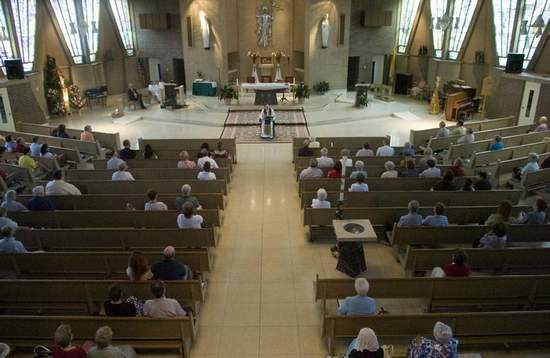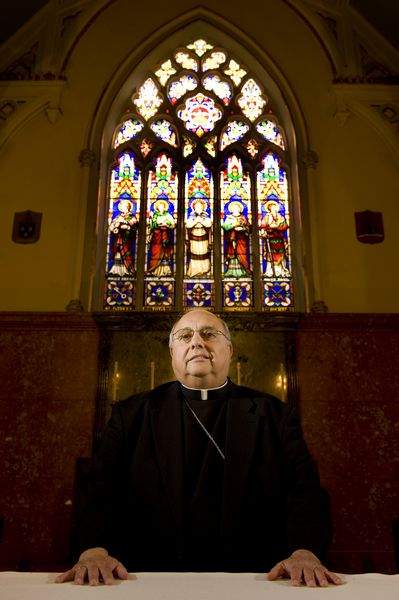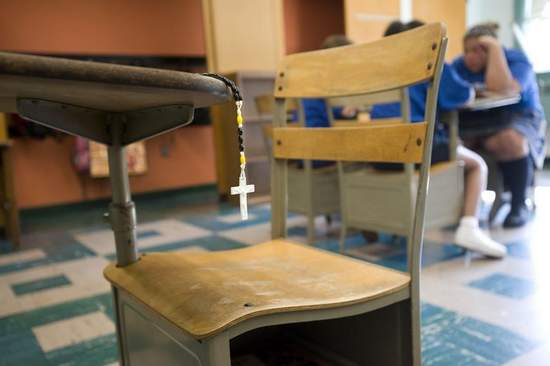Visit Courierpostonline.com/churchclose for Past Galleries, Videos, Interactive Features and Past Stories.
By Jim Walsh
Courier-Post
June 22, 2008
http://www.courierpostonline.com/apps/pbcs.dll/article?AID=/20080622/NEWS01/806220378/1006/news01
Over the next year, South Jersey's Catholics will experience a wave of dramatic — and sometimes traumatic — change.
Long-beloved churches will close. Parishes that helped define a spiritual community will disappear. And parochial schools that once rang with the sounds of children will sit silent.
Those losses — which some observers compare to a death in the family — will be controversial casualties in an ongoing campaign by the Diocese of Camden.
The diocese — faced with a worsening priest shortage, aging congregations and shifting demographics — plans to slash its parishes from 124 to 66. And Camden Bishop Joseph Galante said surviving parishes will see a culture change, as they are revitalized with an influx of ministries and new members.
 |
| Msgr. Louis Marucci says 9 a.m. Mass at St. Vincent Pallotti Church in Haddon Township. Church leaders want to reverse a slide in Mass attendance and say more must be done to attract converts and to keep Catholics active in their faith. Photo by Denise Henhoeffer |
"I want alive and vibrant parishes," said Galante.
Not everyone likes the path set by the bishop.
"I still have, like, a knot in my stomach," said Yolanda Aguilar deNeely of Camden, whose parish, Our Lady of Mount Carmel and Fatima, will be merged with two others in the planned restructuring. "A tornado has hit and we're all trying to pick up the pieces."
But the changes and challenges aren't just happening here.
"A number of dioceses (are) making hard decisions to close and merge parishes for a number of different reasons," said Sarah Comiskey, spokeswoman at the Archdiocese of New Orleans, where 27 parishes will be combined as part of a recently announced restructuring.
 |
|
Camden Bishop Joseph Galante favors the merging of parishes in order to support programs for parishioners, but that would mean the end for many long-standing churches. Many parishioners throughout the diocese are unhappy with the restructuring. Photo by Douglas M. Bovitt |
So far this year, church officials have announced planned or actual closings for scores of parishes in dioceses from Brooklyn to Buffalo, N.Y.; Allentown, Pa., to Worcester, Mass.; and Steubenville, Ohio, to LaCrosse, Wis. The trend has also hit the Diocese of Trenton, which is set to merge eight parishes into four in northern Burlington County on July 1.
"We are in a very, very, very difficult stage," said Robert Tayek, a Cleveland diocese spokesman who predicts more than 20 parishes could close there.
And just like Galante, bishops elsewhere want future parishes to offer more programs — particularly for younger Catholics, immigrants and the poor.
The church leaders — eager to reverse a sharp slide in Mass attendance — also say more must be done to attract converts, to promote religious vocations, and to keep Catholics active in their faith.
 |
| A rosary hangs on a desk on the final day of classes at Queen of Heaven School in Cherry Hill. The school is merging in the fall with St. Peter Celestine to form Resurrection School, something that's happening in many parishes nationwide. Photo by Denise Henhoeffer |
"We'd prefer our money go into ministries, instead of maintenance," said Kevin Keenan, a spokesman for the Diocese of Buffalo. The New York diocese is preparing to merge or link 25 parishes, part of a two-year effort that will close 77 "weekend worship sites."
An overdue change The widespread restructuring is an overdue change that has been put off before because it requires the painful step of church closings, said Mary Gautier, a senior researcher at the Center for Applied Research in the Apostolate at Georgetown University.
"I call it kind of deferred maintenance," she said. "The situation has been endemic for years but the tipping point now is the priest shortage."
She said church closings, particularly in the Northeast and Upper Midwest, will allow dioceses to adjust to long-term population trends. Most notably, many Catholics in European ethnic groups have moved away from the Church's urban base.
The local diocese, for instance, is seeing strong growth in suburban Gloucester County, where several parishes serve more than 2,000 families each.
Any original material on these pages is copyright © BishopAccountability.org 2004. Reproduce freely with attribution.